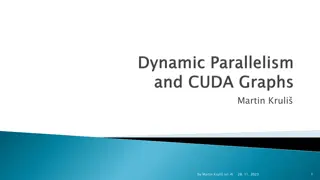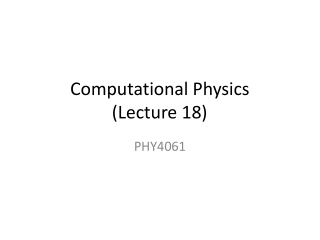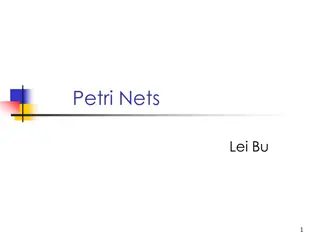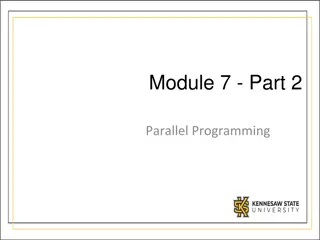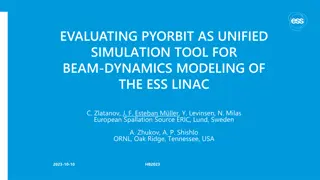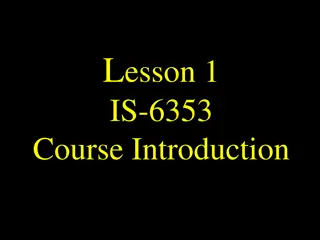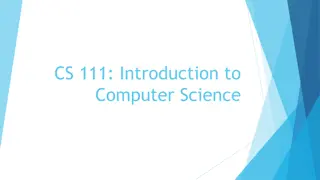Crash Course in Supercomputing: Understanding Parallelism and MPI Concepts
Delve into the world of supercomputing with a crash course covering parallelism, MPI, OpenMP, and hybrid programming. Learn about dividing tasks for efficient execution, exploring parallelization strategies, and the benefits of working smarter, not harder. Discover how everyday activities, such as preparing dinner, can be likened to parallel execution in supercomputing, and differentiate between serial and parallel task performance.
Download Presentation
Please find below an Image/Link to download the presentation.
The content on the website is provided AS IS for your information and personal use only. It may not be sold, licensed, or shared on other websites without obtaining consent from the author. Download presentation by click this link. If you encounter any issues during the download, it is possible that the publisher has removed the file from their server.
Presentation Transcript
Crash Course in Supercomputing Rebecca Hartman-Baker, PhD User Engagement Group Lead Charles Lively III, PhD Science Engagement Engineer Computing Sciences Summer Student Program & NERSC/ALCF/OLCF Supercomputing User Training 2022 June 22, 2023 1
Course Outline Parallelism & MPI (01:00 - 3:00 pm) I. Parallelism II. Supercomputer Architecture III.Basic MPI (Interlude 1: Computing Pi in parallel) I. MPI Collectives (Interlude 2: Computing Pi using parallel collectives) OpenMP & Hybrid Programming (3:30 - 5 pm) 2
Course Outline Parallelism & MPI (01:00 3:00 pm) OpenMP & Hybrid Programming (3:30 - 5 pm) I. About OpenMP II. OpenMP Directives III.Data Scope IV.Runtime Library Routines & Environment V. Using OpenMP (Interlude 3: Computing Pi with OpenMP) VI.Hybrid Programming (Interlude 4: Computing Pi with Hybrid Programming) 3
I. PARALLELISM Parallel Worlds by aloshbennett from http://www.flickr.com/photos/aloshbennett/3209564747/sizes/l/in/photostream/ 5
I. Parallelism Concepts of parallelization Serial vs. parallel Parallelization strategies 6
What is Parallelism? Generally Speaking: Parallelism lets us work smarter, not harder, by simultaneously tackling multiple tasks. How? the concept of dividing a task or problem into smaller subtasks that can be executed simultaneously. Benefit? Work can get done more efficiently, thus quicker! 7
Parallelization Concepts This concept applies to both everyday activities like preparing dinner: Imagine preparing a lasagna dinner with multiple tasks involved. Some tasks, such as making the sauce, assembling the lasagna, and baking it, can be performed independently and concurrently. These tasks do not depend on each other's completion, allowing for parallel execution. r 8
Serial vs. Parallel Serial: tasks must be performed in sequence Parallel: tasks can be performed independently in any order Unlocking the Power of Parallel Computing in Julia Programming by Ombar Karacharekar, from https://omkaracharekar.hashnode.dev/unlocking-the-power-of-parallel- computing-in-julia-programming 9
Serial vs. Parallel: Example Preparing lasagna dinner SERIAL TASKS PARALLEL TASKS Making the sauce Assembling the lasagna Baking the lasagna Washing lettuce Cutting vegetables Assembling the salad Making the lasagna Making the salad Setting the table 10
Serial vs. Parallel: Graph Synchronization Points 12
Serial vs. Parallel: Example Could have several chefs, each performing one parallel task This is concept behind parallel computing 14
Discussion: Jigsaw Puzzle* Suppose we want to do a large, N- piece jigsaw puzzle (e.g., N = 10,000 pieces) Time for one person to complete puzzle: T hours How can we decrease walltime to completion? 15
Discussion: Jigsaw Puzzle Impact of having multiple people at the table Walltime to completion Communication Resource contention Let number of people = p Think about what happens when p = 1, 2, 4, 5000 16
Discussion: Jigsaw Puzzle Alternate setup: p people, each at separate table with N/p pieces each What is the impact on Walltime to completion Communication Resource contention? 17
Discussion: Jigsaw Puzzle Alternate setup: divide puzzle by features, each person works on one, e.g., mountain, sky, stream, tree, meadow, etc. What is the impact on Walltime to completion Communication Resource contention? 18
Parallel Algorithm Design: PCAM Partition Decompose problem into fine-grained tasks to maximize potential parallelism Communication Determine communication pattern among tasks Agglomeration Combine into coarser-grained tasks, if necessary, to reduce communication requirements or other costs Mapping Assign tasks to processors, subject to tradeoff between communication cost and concurrency 19 (from Heath: Parallel Numerical Algorithms)
II. ARCHITECTURE Architecture by marie-ll, http://www.flickr.com/photos/grrrl/324473920/sizes/l/in/photostream/ 20
II. Supercomputer Architecture What is a supercomputer? Conceptual overview of architecture HPE-Cray Shasta Architecture (2021) Cray 1 (1976) IBM Blue Gene (2005) Cray XT5 (2009) 21
What Is a Supercomputer? The biggest, fastest computer right this minute. Henry Neeman Generally, at least 100 times more powerful than PC This field of study known as supercomputing, high- performance computing (HPC), or scientific computing Scientists utilize supercomputers to solve complex problems. Really hard problems need really LARGE (super)computers 22
SMP Architecture SMP stands for Symmetric Multiprocessing architecture commonly used in supercomputers, servers, and high-performance computing environments. all processors have equal access to memory and input/output devices. Massive memory, shared by multiple processors Any processor can work on any task, no matter its location in memory Ideal for parallelization of sums, loops, etc. SMP systems and architectures allow for better load balancing and resource utilization across multiple processors. 23
Cluster Architecture CPUs on racks, do computations (fast) Communicate through networked connections (slow) Want to write programs that divide computations evenly but minimize communication 24
State-of-the-Art Architectures Today, hybrid architectures very common Multiple {16, 24, 32, 64, 68, 128}-core nodes, connected to other nodes by (slow) interconnect Cores in node share memory (like small SMP machines) Machine appears to follow cluster architecture (with multi-core nodes rather than single processors) To take advantage of all parallelism, use MPI (cluster) and OpenMP (SMP) hybrid programming 26
State-of-the-Art Architectures Hybrid CPU/GPGPU architectures also very common Nodes consist of one (or more) multicore CPU + one (or more) GPU Heavy computations offloaded to GPGPUs Separate memory for CPU and GPU Complicated programming paradigm, outside the scope of today s training Often use CUDA to directly program GPU offload portions of code Alternatives: standards-based directives, OpenACC or OpenMP offloading; programming environments such as Kokkos or Raja 27
III. BASIC MPI MPI Adventure by Stefan J rgensen, from http://www.flickr.com/photos/94039982@N00/6177616380/sizes/l/in/photostream/ 28
III. Basic MPI Introduction to MPI Parallel programming concepts The Six Necessary MPI Commands Example program 29
Introduction to MPI Stands for Message Passing Interface Industry standard for parallel programming (200+ page document) MPI implemented by many vendors; open source implementations available too Cray, IBM, HPE vendor implementations MPICH, LAM-MPI, OpenMPI (open source) MPI function library is used in writing C, C++, or Fortran programs in HPC 30
Introduction to MPI MPI-1 vs. MPI-2: MPI-2 has additional advanced functionality and C++ bindings, but everything learned in this section applies to both standards MPI-3: Major revisions (e.g., nonblocking collectives, extensions to one-sided operations), released September 2012, 800+ pages MPI-3.1 released June 2015 MPI-3 additions to standard will not be covered today MPI-4: Standard released June, 2021 MPI-4 additions to standard will also not be covered today 31
Parallelization Concepts Two primary programming paradigms: SPMD (single program, multiple data) MPMD (multiple programs, multiple data) MPI can be used for either paradigm 32
SPMD vs. MPMD SPMD: Write single program that will perform same operation on multiple sets of data Multiple chefs baking many lasagnas Rendering different frames of movie MPMD: Write different programs to perform different operations on multiple sets of data Multiple chefs preparing four-course dinner Rendering different parts of movie frame Can also write hybrid program in which some processes perform same task 33
The Six Necessary MPI Commands int MPI_Init(int *argc, char **argv) int MPI_Finalize(void) int MPI_Comm_size(MPI_Comm comm, int *size) int MPI_Comm_rank(MPI_Comm comm, int *rank) int MPI_Send(void *buf, int count, MPI_Datatype datatype, int dest, int tag, MPI_Comm comm) int MPI_Recv(void *buf, int count, MPI_Datatype datatype, int source, int tag, MPI_Comm comm, MPI_Status *status) 34
Initiation and Termination MPI_Init(int *argc, char **argv) initiates MPI Place in body of code after variable declarations and before any MPI commands MPI_Finalize(void) shuts down MPI Place near end of code, after last MPI command 35
Environmental Inquiry MPI_Comm_size(MPI_Comm comm, int *size) Find out number of processes Allows flexibility in number of processes used in program MPI_Comm_rank(MPI_Comm comm, int *rank) Find out identifier of current process 0 rank size-1 36
Message Passing: Send MPI_Send(void *buf, int count, MPI_Datatype datatype, int dest, int tag, MPI_Comm comm) Send message of length count items and datatype datatype contained in buf with tag tag to process number dest in communicator comm E.g., MPI_Send(&x, 1, MPI_DOUBLE, manager, me, MPI_COMM_WORLD) 37
Message Passing: Receive MPI_Recv(void *buf, int count, MPI_Datatype datatype, int source, int tag, MPI_Comm comm, MPI_Status *status) Receive message of length count items and datatype datatype with tag tag in buffer buf from process number source in communicator comm, and record status status E.g. MPI_Recv(&x, 1, MPI_DOUBLE, source, source, MPI_COMM_WORLD, &status) 38
Message Passing WARNING! Both standard send and receive functions are blocking MPI_Recv returns only after receive buffer contains requested message MPI_Send may or may not block until message received (usually blocks) Must watch out for deadlock 39
Deadlocking Example (Always) #include <mpi.h> #include <stdio.h> int main(int argc, char **argv) { int me, np, q, sendto; MPI_Status status; MPI_Init(&argc, &argv); MPI_Comm_size(MPI_COMM_WORLD, &np); MPI_Comm_rank(MPI_COMM_WORLD, &me); if (np%2==1) return 0; if (me%2==1) {sendto = me-1;} else {sendto = me+1;} MPI_Recv(&q, 1, MPI_INT, sendto, sendto, MPI_COMM_WORLD, &status); MPI_Send(&me, 1, MPI_INT, sendto, me, MPI_COMM_WORLD); printf( Sent %d to proc %d, received %d from proc %d\n , me, sendto, q, sendto); MPI_Finalize(); return 0; } 41
Deadlocking Example (Sometimes) #include <mpi.h> #include <stdio.h> int main(int argc, char **argv) { int me, np, q, sendto; MPI_Status status; MPI_Init(&argc, &argv); MPI_Comm_size(MPI_COMM_WORLD, &np); MPI_Comm_rank(MPI_COMM_WORLD, &me); if (np%2==1) return 0; if (me%2==1) {sendto = me-1;} else {sendto = me+1;} MPI_Send(&me, 1, MPI_INT, sendto, me, MPI_COMM_WORLD); MPI_Recv(&q, 1, MPI_INT, sendto, sendto, MPI_COMM_WORLD, &status); printf( Sent %d to proc %d, received %d from proc %d\n , me, sendto, q, sendto); MPI_Finalize(); return 0; } 42
Deadlocking Example (Safe) #include <mpi.h> #include <stdio.h> int main(int argc, char **argv) { int me, np, q, sendto; MPI_Status status; MPI_Init(&argc, &argv); MPI_Comm_size(MPI_COMM_WORLD, &np); MPI_Comm_rank(MPI_COMM_WORLD, &me); if (np%2==1) return 0; if (me%2==1) {sendto = me-1;} else {sendto = me+1;} if (me%2 == 0) { MPI_Send(&me, 1, MPI_INT, sendto, me, MPI_COMM_WORLD); MPI_Recv(&q, 1, MPI_INT, sendto, sendto, MPI_COMM_WORLD, &status); } else { MPI_Recv(&q, 1, MPI_INT, sendto, sendto, MPI_COMM_WORLD, &status); MPI_Send(&me, 1, MPI_INT, sendto, me, MPI_COMM_WORLD); } printf( Sent %d to proc %d, received %d from proc %d\n , me, sendto, q, sendto); MPI_Finalize(); return 0; } 43
Explanation: Always Deadlocking Example Logically incorrect Deadlock caused by blocking MPI_Recvs All processes wait for corresponding MPI_Sends to begin, which never happens 44
Explanation: Sometimes Deadlocking Example Logically correct Deadlock could be caused by MPI_Sends competing for buffer space Unsafe because depends on system resources Solutions: Reorder sends and receives, like safe example, having evens send first and odds send second Use non-blocking sends and receives or other advanced functions from MPI library (see MPI standard for details) 45
INTERLUDE 1: COMPUTING PI IN PARALLEL Pi of Pi by spellbee2, from http://www.flickr.com/photos/49825386@N08/7253578340/sizes/l/in/photostream/ 46
Interlude 1: Computing ? in Parallel Project Description Serial Code Parallelization Strategies Your Assignment 47
Project Description We want to compute ? One method: method of darts* Ratio of area of square to area of inscribed circle proportional to ? * This is a TERRIBLE way to compute pi! Don t do this in real life!!!! (See Appendix 1 for better ways) Picycle by Tang Yau Hoong, from http://www.flickr.com/photos/tangyauhoong/5 609933651/sizes/o/in/photostream/ 48
Method of Darts Imagine dartboard with circle of radius R inscribed in square Area of circle Area of square Area of circle Area of square Dartboard by AndyRobertsPhotos, from http://www.flickr.com/photos/aroberts/290 7670014/sizes/o/in/photostream/ 49
Method of Darts Ratio of areas proportional to ? How to find areas? Suppose we threw darts (completely randomly) at dartboard Count # darts landing in circle & total # darts landing in square Ratio of these numbers gives approximation to ratio of areas Quality of approximation increases with # darts thrown 50


